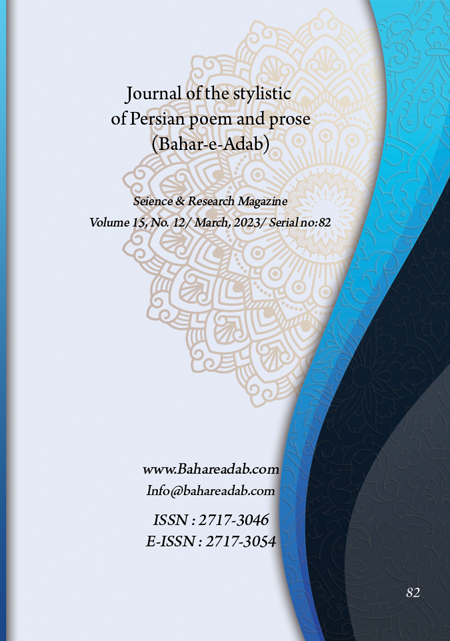- Count View : 334
- آدرس کوتاه شده مقاله: https://bahareadab.com/article_id/1411
- کد doi مقاله: Doi: 10.22034/bahareadab.2023 .15 .7695
Journal of the stylistic of Persian poem and prose
volume Number 15،
number In Volume 12،
،
issue Number 82
Investigating the conceptual metaphor of love in Sa’adi 's Sonnet based on the theories of Lakoff and Johnson
Nazanin Baharvand , Masood Sepahvandi (Author in Charge), Ghasem Sahraei
Abstract
BACKGROUND AND OBJECTIVES: It can be said that in the theory of conceptual metaphor, the metaphors depend on the conceptual and semantic relationship ofintermediate words, which act as a tool for understanding and conceivinga kind of human understanding ofphenomena and abstractand tangible world affairs, as well. The literature on conceptual metaphor theory has various origins and destinations through which it explains the concepts of the mind to the reader in a tangible way. The main purpose of this research is to study poems of Sa’adi"s Sonnets whose field of origin or destination with the concept of "love”has been paid attention by poet.
METHODOLOGY: The research method of this research is descriptive - analytical basedon library studies and the documentation methodbased on the selection of lyric poems in which love and its semantic clusters have been paid more attention.
FINDINGS: According to studies, love has a high value and place Sa’adi"s words. Sa’adi" s view on the issue of love is a positive and very imaginative view.
CONCLUSION: The research results indicate that the conceptual metaphor of love in Sa’adi"s world view and intellectual view, which is itself derive from a conceptual system has overshadowed the structure of the poet"s mind and thought. In Sa’adi"s lyric poems, love for him isenlightening, life- giving, changeable, healing, purifying, and a restless phenomenon, not onlyrelieves the heart but alsolanguishes it, and love is a murderous robber.
Keyword
Sa’adi
, Sonnet
, conceptual metaphor
, love
, Lakoff and Johnson
- Abbasi. Zahra. (2018). "Conceptual metaphor and related semantic clusters in Attar's memoirs" Research in mystical literature (Gohar Goya). (2) 12, pp. 146-117.
- Afrashi. Azita et al. (2015). "Conceptual metaphors in Persian: cognitive and morphological analysis". Journal of Linguistics. 6 (2). pp. 61-39.
- Golfam. Arsalan and Yousefi Rad. Fatima. (2002). "Linguistics and Metaphor" Cognitive Science News. (3) 4, pp. 59-6.
- Haqjoo. Siavash and Eskandari. Saeed. (2014). "Metaphor in the views of Jorjani and Sakaki". Two quarterly journals of Persian language and literature. (77) 22, pp. 89-64.
- Hashemi. Venus. (2010). "Study of metaphorical systems of love in five mystical texts based on cognitive metaphorical theory" PhD thesis. Mashhad: Ferdowsi University. pp. 122 - 123.
- Hawks. (1998). Metaphor. Translated by Farzaneh Taheri. Tehran: Markaz Publishing, p.135.
- Jahez. Omar Ibn Bahr. (1412.AH). Expression and explanation. Research and commentary by Abdul Salam Mohammad Haroon. Vol. 4. Beirut: Al-Hilal. P.152.
- Jorjani. Abdul Qahir. (1998). Secrets of rhetoric in the science of expression. Beirut. Dar al-Kitab al-Alamiya.
- Lakoff. George and Johnson (1980). Metaphors we Live by. Chicago. University of chicago press. pp. 123 124.
- Lakoff. George and Johnson. Mark. (2018). The metaphors we live with; Attached to the article Contemporary Theory of Metaphor. Translated by Jahanshah Mirzabeigi. Second Edition. Tehran: Agah. p. 17-124-123.
- Mohammadi Asyabadi. Ali et al. (2012). "Volumetric schemas and its application in Meybodi mystical language" Mystical literary researches (Gohargovia). (2) 6, pp. 162-141.
- Qaderi. Suleiman. (2013). "Metaphor, body and culture: the concept of heart, liver and eyes in Saadi Park" Literary criticism. (23) 6, pp.105-123.
- Qorbani Madvani & Zohreh and Aghababaei. Somayeh. (2021). "Comparative analysis of conceptual metaphors in the poems of Forough Farrokhzad and Ghada Al-Saman based on the conceptual field of love" Literary textual research. (89) 25, pp. 305-274.
- Safavi. Cyrus. (2000). Descriptive semantic culture. Tehran: Contemporary Culture. P. 367.
- Safavi. Cyrus. (2004). From linguistics to literature. Vol.1. Tehran: Surah Mehr. P.512.
- Safavi. Cyrus. (2007). An Introduction to Semantics. Research Institute of Islamic Culture and Art. Tehran: Surah Mehr. P.92.
- Shahri. Bahman. (2012). "Links between Metaphor and Ideology" Literary Criticism. No. 19. pp. 76-59.
- Shamisa. Sirus. (2006). Expression. Tehran: Mitra. P.52.
- Zahedi. Seyed Akram et al. (1401). "A Study of the Conceptual Metaphor of Time in Hafez's Poetry and the World of Malek Khatoon" Scientific Journal of Persian Stylistics and Prose. (71) 15, pp. 196-173.
- Zarqani. Seyed Mehdi et al. (2013). "Cognitive analysis of love metaphors in Sanai lyric poems" Literary essays. No. 183/3. pp. 1-30.
- Zarrinkub, Abdolhosein. (2012). Saadi's Hadith: About Saadi's life and thought. Prepared and arranged by: Jandaghi Ejtema’i. Tehran: Sokhan, pp. 204 and 172.
- Ziya. Movahhed. (2013). Sa’adi. Tehran: Niloufar. pp. 71-90.

